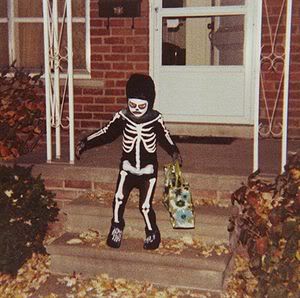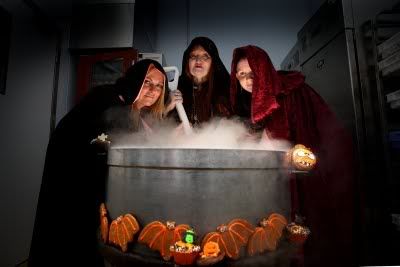
Trick or treating is traditional in the USA but recently it has come here.
So children, the small ones accompanied by adults, wearing costumes, knock on your door, saying 'trick or treat'.
The "trick" is an (hopefully) idle threat to perform mischief on the homeowners or their property, such as Eggs and Flour being thrown at householders windows if no treat is given.
In the United States and Canada, trick-or-treating is now one of the main traditions of Halloween and it has become socially expected that if one lives in a neighborhood with children one should purchase treats in preparation for trick-or-treaters. The National Confectioners Association reported in 2005 that 80 percent of adults in the United States planned to give out confectionery to trick-or-treaters, and that 93 percent of children planned to go trick-or-treating.
When I was growing up I never heard of this happening, but one year, about 4 years ago, a few children knocked on my door, but I had no sweets in the house. What are you meant to do? Hide in the dark and hope they go away? I had some fruit in the house and that seemed to be acceptable. One year I bought some sweets, then no one came, and I ended up eating it all, which was not good for me. So now I just have apples, though I feel a bit like Scrooge.
Debrett's has posted its advice on its Web site. "Halloween fun should never feel menacing," it says. "Children should not be too greedy — if they are offered treats, make sure that they don't take too many and that they do say thank you." If you really don't want to be bothered by trick-or-treaters, it is perfectly acceptable to leave a bowl of treats at your doorsteps so children can help themselves.
The earliest known reference to ritual begging on Halloween in English speaking North America occurs in 1911, when a newspaper in Kingston, Ontario reported that it was normal for the smaller children to go street 'guising' on Halloween between 6 and 7 p.m., visiting shops and neighbors to be rewarded with nuts and candies for their rhymes and songs. Trick-or-treating does not seem to have become a widespread practice until the 1930s. Its reported in newspapers from the mid-1930s to the mid-1950s, typically saw it as a form of extortion, with reactions ranging from bemused indulgence to anger.
Before the 1980s, the North American phrase "trick-or-treat" was little known in the UK and when introduced was often regarded as an unusual and even unwelcome import, because "trick or treat" isn't a tradition, with Halloween an authentically ancient festival, about the links between life and death, the struggle between light and dark. It has now become more widespread, but is still often viewed as an exotic and unwelcome commercialised import, referred to as "the Japanese knotweed of festivals" and "Making demands with menaces".
Halloween is now a multi-million pound industry in the UK, with some retailers seeing 31 October emerging as the second most lucrative trading period of the year after Christmas (and overtaking Easter). Last year, sales of Halloween items, including costumes, themed food and drink, sweets and decorations, were expected to top £195m, rising from an estimated £12m in 2001. According to analysts, British Halloween spending is catching up with the US, where an average family spends approximately £65 on Halloween paraphernalia in a nationwide industry said to be worth £4.7 billion.
According to retailers in the UK and the US, Michael Jackson and the convicted Ponzi fraudster Bernard Madoff are among the most popular costume choices for 2009!

Greggs the baker invited a local coven of witches into its bakery in Manchester. Amethyst, Amber and Aquamarine blessed the recipes for a range of Halloween treats including bat biscuits, toffee apple lattices and creepy cupcakes before they were sent to 1,400 outlets across the UK. "We were delighted to be invited by Greggs to cast a positive blessing on the bakery and the goodies they're making," says Amethyst. "The traditional blessing we use brings protection and prosperity during an important and ancient British festival and it's great to think we're passing on some positivity to Greggs' customers around the country and at the same time dispelling some of the myths and stereotypes that surround our Craft."

People looked at Halloween and saw a festival that seemed ancient, pre-Christian and down-right pagan with its customs of dressing up, dancing around bonfires, making lanterns out of turnips (or pumpkins in the USA). They looked a bit further and saw a description in an old Irish tale of the festival of Samhain, meaning "the end of summer", which was celebrated on November 1. They put two and two together and it became accepted history that the origins of Halloween were in the Celtic feast of Samhain. The Catholic Church, under Pope Gregory III, moved All Saints' Day, a day to honour all the saints, from May 13 to November 1 in the 8th century.
Halloween is also traditionally connected to the Christian celebration of All Saints; a link that has largely been forgotten. The Bishop of Bolton, the Right Rev David Gillett wants to celebrate the saints who are the heroes of the Christian faith at Haloween.






No comments:
Post a Comment